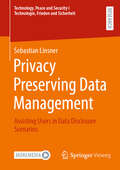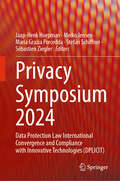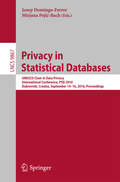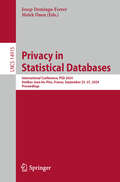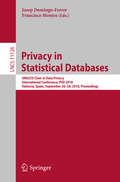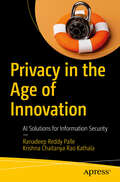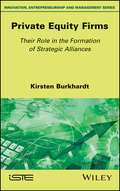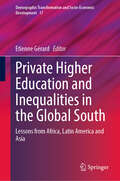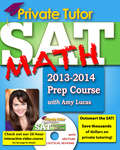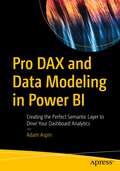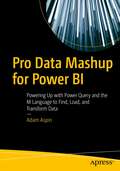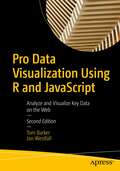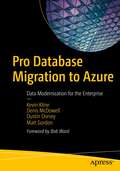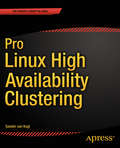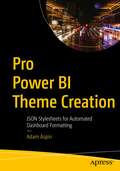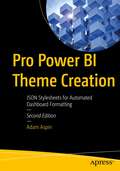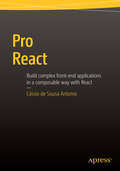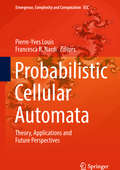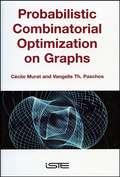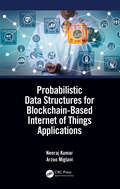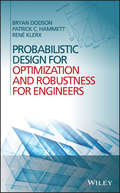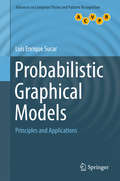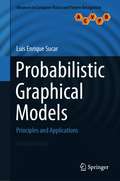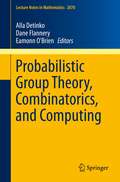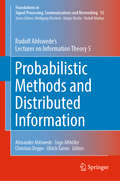- Table View
- List View
Privacy Preserving Data Management: Assisting Users in Data Disclosure Scenarios (Technology, Peace and Security I Technologie, Frieden und Sicherheit)
by Sebastian LinsnerUsers face many situations in which they have to disclose their data to others. In many cases, they are not properly informed about the usage of their data or the consequences of data disclosure. This book investigates how users can be supported by researching three core aspects: Firstly, problems and risks that lead to (unintended) data disclosure or arise from it have to be identified. Secondly, measures are investigated that developers can apply to mitigate these risks and meet the needs of the users. Finally, the developed solutions have to be adopted into practice. Strategies to bring security- and privacy-enhancing technologies to use are essential because a tool that is not used cannot protect anyone. The investigated scenarios are twofold: Firstly, business-to-business (B2B) collaborations, especially highlighting the perspective of owners of small and medium enterprises (SMEs) who are forced to provide data for business processes. Secondly, scenarios of everyday usage for private users that require the disclosure of data are investigated.
Privacy Symposium 2024: Data Protection Law International Convergence and Compliance with Innovative Technologies (DPLICIT)
by Stefan Schiffner Jaap-Henk Hoepman Sébastien Ziegler Maria Grazia Porcedda Meiko JensenThis book presents the proceedings of the Privacy Symposium 2024. The book features a collection of high-quality research works and professional perspectives on personal data protection and emerging technologies. Gathering legal and technology expertise, it provides cutting-edge perspective on international data protection regulations convergence, as well as data protection compliance of emerging technologies, such as artificial intelligence, e-health, blockchain, edge computing, Internet of Things, V2X, and smart grid. Papers encompass various topics, including international law and comparative law in data protection and compliance, cross-border data transfer, emerging technologies and data protection compliance, data protection by design, technology for compliance and data protection, data protection good practices across industries and verticals, cybersecurity and data protection, assessment and certification of data protection compliance, and data subject rights implementation.
Privacy in Statistical Databases
by Josep Domingo-Ferrer Mirjana Pejić-BachThis book constitutes the refereed proceedings of the International Workshop on Privacy in Statistical Databases, PSD 2004, held in June 2004 in Barcelona, Spain as the final conference of the European IST Project Computational Aspects of Statistical Confidentiality. The 29 revised full papers presented were carefully reviewed and selected from 44 submissions. The papers are organized in topical sections on foundations of tabular protection, methods for tabular protection, masking for microdata protection, risks in microdata protection, synthetic data, and software and case studies.
Privacy in Statistical Databases: International Conference, PSD 2024, Antibes Juan-les-Pins, France, September 25–27, 2024, Proceedings (Lecture Notes in Computer Science #14915)
by Josep Domingo-Ferrer Melek ÖnenThis book constitutes the refereed proceedings of the International Conference on Privacy in Statistical Databases, PSD 2024, held in Antibes Juan-les-Pins, France, during September 25-27, 2024. The 28 papers presented in this volume were carefully reviewed and selected from 46 submissions. They were organized in topical sections as follows: Privacy models and concepts; Microdata protection; Statistical table protection; Synthetic data generation methods; Synthetic data generation software; Disclosure risk assessment; Spatial and georeferenced data; Machine learning and privacy; and Case studies.
Privacy in Statistical Databases: UNESCO Chair in Data Privacy, International Conference, PSD 2018, Valencia, Spain, September 26–28, 2018, Proceedings (Lecture Notes in Computer Science #11126)
by Josep Domingo-Ferrer Francisco MontesThis book constitutes the refereed proceedings of the International Conference on Privacy in Statistical Databases, PSD 2018, held in Valencia, Spain, in September 2018 under the sponsorship of the UNESCO Chair in Data Privacy. The 23 revised full papers presented were carefully reviewed and selected from 42 submissions. The papers are organized into the following topics: tabular data protection; synthetic data; microdata and big data masking; record linkage; and spatial and mobility data.Chapter "SwapMob: Swapping Trajectories for Mobility Anonymization" is available open access under a Creative Commons Attribution 4.0 International License via link.springer.com.
Privacy in the Age of Innovation: AI Solutions for Information Security
by Ranadeep Reddy Palle Krishna Chaitanya KathalaThis book will help you comprehend the impact of artificial intelligence (AI) on information security, data privacy, and data security.The book starts by explaining the basics and setting the goals for a complete understanding of how AI, Information Security, Data Privacy, and Data Security all connect. Then, it gives you important information about the basics of AI, machine learning, and deep learning in simple terms. It also talks about the ethics of using AI in privacy and security, making sure you understand the power and responsibility that come with AI. Next, it takes you through the complex world of information security and data privacy. It covers everything from the current state of security to how AI can detect threats and protect privacy. Additionally, it delves into ethical considerations to ensure the responsible use of AI in managing data privacy. Later chapters discuss strategies and future trends in using AI for data security, finding the right balance between security and privacy, and giving useful advice for organizations.In the end, this book examines the current landscape and foresees the future, underscoring the vital importance of maintaining a balance between innovation and privacy in AI-powered security.What you will learn:How AI is being used to detect and prevent cyberattacks in real-timeWhat are the AI-powered techniques for anonymizing and de-identifying data,What are the latest advancements in AI-powered privacy-enhancing technologies (PETs)How to find the right balance between security and privacyWho this book is for:Information security professionals, data scientists, and software developers seeking to gain an understanding of the latest trends and techniques in AI for information security
Private Equity Firms: Their Role in the Formation of Strategic Alliances
by Kirsten BurkhardtThis work analyzes the role of private equity firms (SCIs) in forming strategic alliances in the French private equity market. The subject is important because the formation of alliances and, more generally, the networking of SMEs, could be an alternative to the lack of medium-sized companies in France. For French SCIs, which are increasingly in a competitive situation, assistance in forming alliances for their holdings may represent a new activity and be a source of competitive advantage. The work is positioned transversally, touching the areas of corporate governance, entrepreneurial finance and strategy.
Private Higher Education and Inequalities in the Global South: Lessons from Africa, Latin America and Asia (Demographic Transformation and Socio-Economic Development #17)
by Etienne GérardBased on original findings from research carried out in six low- and middle-income countries in Africa, Asia and Latin America, this book brings together conceptual and empirical analyses of private higher education and social and academic inequality, a topic largely unexplored in the social science literature, particularly on private higher education. Field surveys of different categories of actors in numerous private universities have combined common methods and tools in countries chosen for the differences in their social structures and the characteristics, organization and development of their private higher education systems. Based on these qualitative surveys, combined with available quantitative data on higher education, this book analyzes the production and reproduction of social and academic inequalities in countries as diverse as Argentina, Malaysia, Mexico, Peru, the Democratic Republic of Congo, Senegal and Vietnam. Finally, the historical and social structuringof the private education systems in the selected countries provides the framework for analyses that go beyond the traditional higher education demand/supply and public policy approaches to explore the perspective of the actors – institutional administrators, teaching staff and students.
Private Tutor - SAT Math 2013-2014 Prep Course
by Amy LucasThe purchase of this eBook includes an offer for a FREE DVD or Digital Download of 2 hours from our 20-hour SAT prep video course. Private Tutor SAT Math 2013-2014 Prep Course is a critically-praised, low cost alternative to the often unaffordable tutoring industry. Students can achieve the results of private tutoring at a fraction of the cost. This complete course covers all aspects of the SAT Math sections including numerous practice drills with detailed answer explanations. Written by Amy Lucas, a Summa Cum Laude graduate of UCLA with fifteen years of experience as an SAT Master Tutor and Education Specialist. The School Library Journal Starred Review stated "Library collections serving high school students as well as homeschoolers seeking instruction, practice, and basic standardized test-taking tips for the Math SAT will find this series an essential purchase." The Library Journal stated, " Verdict: highly recommended for students taking the SATs." Math book can be used alone or with the corresponding 10-hour DVD course. * Achieve the results of Private Tutoring at a fraction of the cost! * SAT Math Vocabulary from Integers to Modes * Narrowing down Answer Choices faster * Includes everything from Arithmetic & Algebra to 3D Figures & Coordinate Geometry * Practice drills with Answers and Explanations * Personal one-to-one approach from an experienced Master Tutor INCLUDES: * Math Vocabulary * Basic Plugging * Must Be/Could Be Problems * Answer Choice Test (A.C.T.) * Sneaky Plug-in * Arithmetic Lesson * Algebra Lesson * Geometry Lesson * Functions Lesson * Drills and Answer Explanations
Pro DAX and Data Modeling in Power BI: Creating the Perfect Semantic Layer to Drive Your Dashboard Analytics
by Adam AspinDevelop powerful data models that bind data from disparate sources into a coherent whole. Then extend your data models using DAX–the query language that underpins Power BI–to create reusable measures to deliver finely-crafted custom calculations in your dashboards.This book starts off teaching you how to define and enhance the core structures of your data model to make it a true semantic layer that transforms complex data into familiar business terms. You’ll learn how to create calculated columns to solve basic analytical challenges. Then you’ll move up to mastering DAX measures to finely slice and dice your data.The book also shows how to handle temporal analysis in Power BI using a Date dimension. You will see how DAX Time Intelligence functions can simplify your analysis of data over time. Finally, the book shows how to extend DAX to filter and calculate datasets and develop DAX table functions and variables to handle complex queries.What You Will LearnCreate clear and efficient data models that support in-depth analyticsDefine core attributes such as data types and standardized formatting consistently throughout a data modelDefine cross-filtering settings to enhance the data modelMake use of DAX to create calculated columns and custom tablesExtend your data model with custom calculations and reusable measures using DAXPerform time-based analysis using a Date dimension and Time Intelligence functionsWho This Book Is ForEveryone from the CEO to the Business Intelligence developer and from BI and Data architects and analysts to power users and IT managers can use this book to outshine the competition and create the data framework that they need and interactive dashboards using Power BI
Pro Data Mashup for Power BI: Powering Up with Power Query and the M Language to Find, Load, and Transform Data
by Adam AspinThis book provides all you need to find data from external sources and load and transform that data into Power BI where you can mine it for business insights and a competitive edge. This ranges from connecting to corporate databases such as Azure SQL and SQL Server to file-based data sources, and cloud- and web-based data sources. The book also explains the use of Direct Query and Live Connect to establish instant connections to databases and data warehouses and avoid loading data. The book provides detailed guidance on techniques for transforming inbound data into normalized data sets that are easy to query and analyze. This covers data cleansing, data modification, and standardization as well as merging source data into robust data structures that can feed into your data model. You will learn how to pivot and transpose data and extrapolate missing values as well as harness external programs such as R and Python into a Power Query data flow. You also will see how to handle errors in source data and extend basic data ingestion to create robust and parameterized data load and transformation processes. Everything in this book is aimed at helping you deliver compelling and interactive insight with remarkable ease using Power BI’s built-in data load and transformation tools.What You Will LearnConnect Power BI to a range of external data sourcesPrepare data from external sources for easy analysis in Power BI Cleanse data from duplicates, outliers, and other bad valuesMake live connections from which to refresh data quickly and easilyApply advanced techniques to interpolate missing dataWho This Book Is ForAll Power BI users from beginners to super users. Any user of the world’s leading dashboarding tool can leverage the techniques explained in this book to turbo-charge their data preparation skills and learn how a wide range of external data sources can be harnessed and loaded into Power BI to drive their analytics. No previous knowledge of working with data, databases, or external data sources is required—merely the need to find, transform, and load data into Power BI..
Pro Data Visualization Using R and JavaScript: Analyze and Visualize Key Data on the Web
by Tom Barker Jon WestfallUse R 4, RStudio, Tidyverse, and Shiny to interrogate and analyze your data, and then use the D3 JavaScript library to format and display that data in an elegant, informative, and interactive way. You will learn how to gather data effectively, and also how to understand the philosophy and implementation of each type of chart, so as to be able to represent the results visually. With the popularity of the R language, the art and practice of creating data visualizations is no longer the preserve of mathematicians, statisticians, or cartographers. As technology leaders, we can gather metrics around what we do and use data visualizations to communicate that information. Pro Data Visualization Using R and JavaScript combines the power of the R language with the simplicity and familiarity of JavaScript to display clear and informative data visualizations. Gathering and analyzing empirical data is the key to truly understanding anything. We can track operational metrics to quantify the health of our products in production. We can track quality metrics of our projects, and even use our data to identify bad code. Visualizing this data allows anyone to read our analysis and easily get a deep understanding of the story the data tells. This book makes the R language approachable, and promotes the idea of data gathering and analysis mostly using web interfaces. What You Will Learn Carry out data visualization using R and JavaScript Use RStudio for data visualization Harness Tidyverse data pipelines Apply D3 and R Notebooks towards your data Work with the R Plumber API generator, Shiny, and more Who This Book Is For Programmers and data scientists/analysts who have some prior experience with R and JavaScript.
Pro Database Migration to Azure: Data Modernization for the Enterprise
by Kevin Kline Matt Gordon Denis McDowell Dustin DorseyMigrate your existing, on-premises applications into the Microsoft Azure cloud platform. This book covers the best practices to plan, implement, and operationalize the migration of a database application from your organization’s data center to Microsoft’s Azure cloud platform.Data modernization and migration is a technologically complex endeavor that can also be taxing from a leadership and operational standpoint. This book covers not only the technology, but also the most important aspects of organization culture, communication, and politics that so frequently derail such projects. You will learn the most important steps to ensuring a successful migration and see battle-tested wisdom from industry veterans. From executive sponsorship, to executing the migration, to the important steps following migration, you will learn how to effectively conduct future migrations and ensure that your team and your database application delivers on the expected business value of the project. This book is unlike any other currently in the market. It takes you through the most critical business and technical considerations and workflows for moving your data and databases into the cloud, with special attention paid to those who are deploying to the Microsoft Data Platform in Azure, especially SQL Server. Although this book focuses on migrating on-premises SQL Server enterprises to hybrid or fully cloud-based Azure SQL Database and Azure SQL Managed Instances, it also cover topics involving migrating non-SQL Server database platforms such as Oracle, MySQL, and PostgreSQL applications to Microsoft Azure.What You Will LearnPlan a database migration that ensures smooth project progress, optimal performance, low operating cost, and minimal downtimeProperly analyze and manage non-technical considerations, such as legal compliance, privacy, and team executionPerform a thorough architectural analysis to select the best Azure services, performance tiers, and cost-containment featuresAvoid pitfalls and common reasons for failure relating to corporate culture, intra-office politics, and poor communicationsSecure the proper executive champions who can execute the business planning needed for successApply proven criteria to determine your future-state architecture and your migration methodExecute your migration using a process proven by the authors over years of successful projectsWho This Book Is ForIT leadership, strategic IT decision makers, project owners and managers, and enterprise and application architects. For anyone looking toward cloud migration projects as the next stage of growth in their careers. Also useful for enterprise DBAs and consultants who might be involved in such projects. Readers should have experience and be competent in designing, coding, implementing, and supporting database applications in an on-premises environment.
Pro Linux High Availability Clustering
by Sander Van VugtPro Linux High Availability Clustering teaches you how to implement this fundamental Linux add-on into your business. Linux High Availability Clustering is needed to ensure the availability of mission critical resources. The technique is applied more and more in corporate datacenters around the world. While lots of documentation about the subject is available on the internet, it isn't always easy to build a real solution based on that scattered information, which is often oriented towards specific tasks only. Pro Linux High Availability Clustering explains essential high-availability clustering components on all Linux platforms, giving you the insight to build solutions for any specific case needed. In this book four common cases will be explained: Configuring Apache for high availabilityCreating an Open Source SAN based on DRBD, iSCSI and HA clusteringSetting up a load-balanced web server cluster with a back-end, highly-available databaseSetting up a KVM virtualization platform with high-availability protection for a virtual machine. With the knowledge you'll gain from these real-world applications, you'll be able to efficiently apply Linux HA to your work situation with confidence. Author Sander Van Vugt teaches Linux high-availability clustering on training courses, uses it in his everyday work, and now brings this knowledge to you in one place, with clear examples and cases. Make the best start with HA clustering with Pro Linux High Availability Clustering at your side
Pro Power BI Theme Creation: JSON Stylesheets for Automated Dashboard Formatting
by Adam AspinUse JSON theme files to standardize the look of Power BI dashboards and reports. This book shows how you can create theme files using the Power BI Desktop application to define high-level formatting attributes for dashboards as well as how to tailor detailed formatting specifications for individual dashboard elements in JSON files. Standardize the look of your dashboards and apply formatting consistently over all your reports. The techniques in this book provide you with tight control over the presentation of all aspects of the Power BI dashboards and reports that you create. Power BI theme files use JSON (JavaScript Object Notation) as their structure, so the book includes a brief introduction to JSON as well as how it applies to Power BI themes. The book further includes a complete reference to all the current formatting definitions and JSON structures that are at your disposal for creating JSON theme files. Finally, the book includes dozens of theme files, from the simple to the most complex, that you can adopt and adapt to suit your own requirements. What You Will LearnProduce designer output without manually formatting every individual visual in a Power BI dashboardStandardize presentation for families of dashboard typesSwitch presentation styles in a couple of clicksSave dozens, or hundreds, of hours laboriously formatting dashboardsDefine enterprise-wide presentation standardsRetroactively apply standard styles to existing dashboardsWho This Book Is ForPower BI users who want to save time by defining standardized formatting for their dashboards and reports, IT professionals who want to create corporate standards of dashboard presentation, and marketing and communication specialists who want to set organizational standards for dashboard delivery
Pro Power BI Theme Creation: JSON Stylesheets for Automated Dashboard Formatting
by Adam AspinUse JSON theme files to standardize the look of Power BI dashboards and reports. This book shows how you can create theme files using the Power BI Desktop application to define high-level formatting attributes for dashboards as well as how to tailor detailed formatting specifications for individual dashboard elements in JSON files. Standardize the look of your dashboards and apply formatting consistently over all your reports. The techniques in this book provide you with tight control over the presentation of all aspects of the Power BI dashboards and reports that you create. Power BI theme files use JSON (JavaScript Object Notation) as their structure, so the book includes a brief introduction to JSON as well as how it applies to Power BI themes. The book further includes a complete reference to all the current formatting definitions and JSON structures that are at your disposal for creating JSON theme files up to the May 2023 release of Power BI Desktop. Finally, the book includes dozens of theme files, from the simple to the most complex, that you can adopt and adapt to suit your own requirements. What You Will Learn Produce designer output without manually formatting every individual visual in a Power BI dashboardStandardize presentation for families of dashboard typesSwitch presentation styles in a couple of clicksSave dozens, or hundreds, of hours laboriously formatting dashboardsDefine enterprise-wide presentation standardsRetroactively apply standard styles to existing dashboards Who This Book Is For Power BI users who want to save time by defining standardized formatting for their dashboards and reports, IT professionals who want to create corporate standards of dashboard presentation, and marketing and communication specialists who want to set organizational standards for dashboard delivery.
Pro React
by Cássio de Sousa AntonioPro React teaches you how to successfully structure increasingly complex front-end applications and interfaces. This book explores the React library in depth, as well as detailing additional tools and libraries in the React ecosystem, enabling you to create complete, complex applications. You will learn how to use React completely, and learn best practices for creating interfaces in a composable way. You will also cover additional tools and libraries in the React ecosystem (such as React Router and Flux architecture). Each topic is covered clearly and concisely and is packed with the details you need to learn to be truly effective. The most important features are given no-nonsense, in-depth treatment, and every chapter details common problems and how to avoid them. If you already have experience creating front-end apps using jQuery or perhaps other JavaScript frameworks, but need to solve the increasingly common problem of structuring complex front-end applications, then this book is for you. Start working with React like a pro - add Pro React to your library today.
Probabilistic Cellular Automata: Theory, Applications And Future Perspectives (Emergence, Complexity And Computation Ser. #27)
by Pierre-Yves Louis Francesca R. NardiThis book explores Probabilistic Cellular Automata (PCA) from the perspectives of statistical mechanics, probability theory, computational biology and computer science. PCA are extensions of the well-known Cellular Automata models of complex systems, characterized by random updating rules. Thanks to their probabilistic component, PCA offer flexible computing tools for complex numerical constructions, and realistic simulation tools for phenomena driven by interactions among a large number of neighboring structures. PCA are currently being used in various fields, ranging from pure probability to the social sciences and including a wealth of scientific and technological applications. This situation has produced a highly diversified pool of theoreticians, developers and practitioners whose interaction is highly desirable but can be hampered by differences in jargon and focus. This book – just as the workshop on which it is based – is an attempt to overcome these difference and foster interest among newcomers and interaction between practitioners from different fields. It is not intended as a treatise, but rather as a gentle introduction to the role and relevance of PCA technology, illustrated with a number of applications in probability, statistical mechanics, computer science, the natural sciences and dynamical systems. As such, it will be of interest to students and non-specialists looking to enter the field and to explore its challenges and open issues.
Probabilistic Combinatorial Optimization on Graphs (Wiley-iste Ser.)
by Vangelis Th. Paschos Cécile MuratThis title provides a comprehensive survey over the subject of probabilistic combinatorial optimization, discussing probabilistic versions of some of the most paradigmatic combinatorial problems on graphs, such as the maximum independent set, the minimum vertex covering, the longest path and the minimum coloring. Those who possess a sound knowledge of the subject mater will find the title of great interest, but those who have only some mathematical familiarity and knowledge about complexity and approximation theory will also find it an accessible and informative read.
Probabilistic Data Structures for Blockchain-Based Internet of Things Applications
by Neeraj Kumar Arzoo MiglaniThis book covers theory and practical knowledge of Probabilistic data structures (PDS) and Blockchain (BC) concepts. It introduces the applicability of PDS in BC to technology practitioners and explains each PDS through code snippets and illustrative examples. Further, it provides references for the applications of PDS to BC along with implementation codes in python language for various PDS so that the readers can gain confidence using hands on experience. Organized into five sections, the book covers IoT technology, fundamental concepts of BC, PDS and algorithms used to estimate membership query, cardinality, similarity and frequency, usage of PDS in BC based IoT and so forth.
Probabilistic Design for Optimization and Robustness for Engineers
by Rene Klerx Patrick Hammett Bryan DodsonProbabilistic Design for Optimization and Robustness: Presents the theory of modeling with variation using physical models and methods for practical applications on designs more insensitive to variation. Provides a comprehensive guide to optimization and robustness for probabilistic design. Features examples, case studies and exercises throughout. The methods presented can be applied to a wide range of disciplines such as mechanics, electrics, chemistry, aerospace, industry and engineering. This text is supported by an accompanying website featuring videos, interactive animations to aid the readers understanding.
Probabilistic Graphical Models
by Luis Enrique SucarThis accessible text/reference provides a general introduction to probabilistic graphical models (PGMs) from an engineering perspective. The book covers the fundamentals for each of the main classes of PGMs, including representation, inference and learning principles, and reviews real-world applications for each type of model. These applications are drawn from a broad range of disciplines, highlighting the many uses of Bayesian classifiers, hidden Markov models, Bayesian networks, dynamic and temporal Bayesian networks, Markov random fields, influence diagrams, and Markov decision processes. Features: presents a unified framework encompassing all of the main classes of PGMs; describes the practical application of the different techniques; examines the latest developments in the field, covering multidimensional Bayesian classifiers, relational graphical models and causal models; provides exercises, suggestions for further reading, and ideas for research or programming projects at the end of each chapter.
Probabilistic Graphical Models: Principles and Applications (Advances in Computer Vision and Pattern Recognition)
by Luis Enrique SucarThis fully updated new edition of a uniquely accessible textbook/reference provides a general introduction to probabilistic graphical models (PGMs) from an engineering perspective. It features new material on partially observable Markov decision processes, graphical models, and deep learning, as well as an even greater number of exercises.The book covers the fundamentals for each of the main classes of PGMs, including representation, inference and learning principles, and reviews real-world applications for each type of model. These applications are drawn from a broad range of disciplines, highlighting the many uses of Bayesian classifiers, hidden Markov models, Bayesian networks, dynamic and temporal Bayesian networks, Markov random fields, influence diagrams, and Markov decision processes.Topics and features:Presents a unified framework encompassing all of the main classes of PGMsExplores the fundamental aspects of representation, inference and learning for each techniqueExamines new material on partially observable Markov decision processes, and graphical modelsIncludes a new chapter introducing deep neural networks and their relation with probabilistic graphical models Covers multidimensional Bayesian classifiers, relational graphical models, and causal modelsProvides substantial chapter-ending exercises, suggestions for further reading, and ideas for research or programming projectsDescribes classifiers such as Gaussian Naive Bayes, Circular Chain Classifiers, and Hierarchical Classifiers with Bayesian NetworksOutlines the practical application of the different techniquesSuggests possible course outlines for instructorsThis classroom-tested work is suitable as a textbook for an advanced undergraduate or a graduate course in probabilistic graphical models for students of computer science, engineering, and physics. Professionals wishing to apply probabilistic graphical models in their own field, or interested in the basis of these techniques, will also find the book to be an invaluable reference.Dr. Luis Enrique Sucar is a Senior Research Scientist at the National Institute for Astrophysics, Optics and Electronics (INAOE), Puebla, Mexico. He received the National Science Prize en 2016.
Probabilistic Group Theory, Combinatorics, and Computing
by Alla Detinko Dane Flannery Eamonn O'BrienProbabilistic Group Theory, Combinatorics and Computing is based on lecture courses held at the Fifth de Brún Workshop in Galway, Ireland in April 2011. Each course discusses computational and algorithmic aspects that have recently emerged at the interface of group theory and combinatorics, with a strong focus on probabilistic methods and results. The courses served as a forum for devising new strategic approaches and for discussing the main open problems to be solved in the further development of each area. The book represents a valuable resource for advanced lecture courses. Researchers at all levels are introduced to the main methods and the state-of-the-art, leading up to the very latest developments. One primary aim of the book's approach and design is to enable postgraduate students to make immediate use of the material presented.
Probabilistic Methods and Distributed Information: Rudolf Ahlswede’s Lectures on Information Theory 5 (Foundations in Signal Processing, Communications and Networking #15)
by Holger Boche Ingo Althöfer Christian Deppe Ulrich Tamm Alexander Ahlswede Rudolf Ahlswede Vladimir Blinovsky Ulrich Krengel Ahmed MansourThe fifth volume of Rudolf Ahlswede’s lectures on Information Theory focuses on several problems that were at the heart of a lot of his research. One of the highlights of the entire lecture note series is surely Part I of this volume on arbitrarily varying channels (AVC), a subject in which Ahlswede was probably the world's leading expert. Appended to Part I is a survey by Holger Boche and Ahmed Mansour on recent results concerning AVC and arbitrarily varying wiretap channels (AVWC). After a short Part II on continuous data compression, Part III, the longest part of the book, is devoted to distributed information. This Part includes discussions on a variety of related topics; among them let us emphasize two which are famously associated with Ahlswede: "multiple descriptions", on which he produced some of the best research worldwide, and "network coding", which had Ahlswede among the authors of its pioneering paper. The final Part IV on "Statistical Inference under Communication constraints" is mainly based on Ahlswede’s joint paper with Imre Csiszar, which received the Best Paper Award of the IEEE Information Theory Society. The lectures presented in this work, which consists of 10 volumes, are suitable for graduate students in Mathematics, and also for those working in Theoretical Computer Science, Physics, and Electrical Engineering with a background in basic Mathematics. The lectures can be used either as the basis for courses or to supplement them in many ways. Ph.D. students will also find research problems, often with conjectures, that offer potential subjects for a thesis. More advanced researchers may find questions which form the basis of entire research programs.
